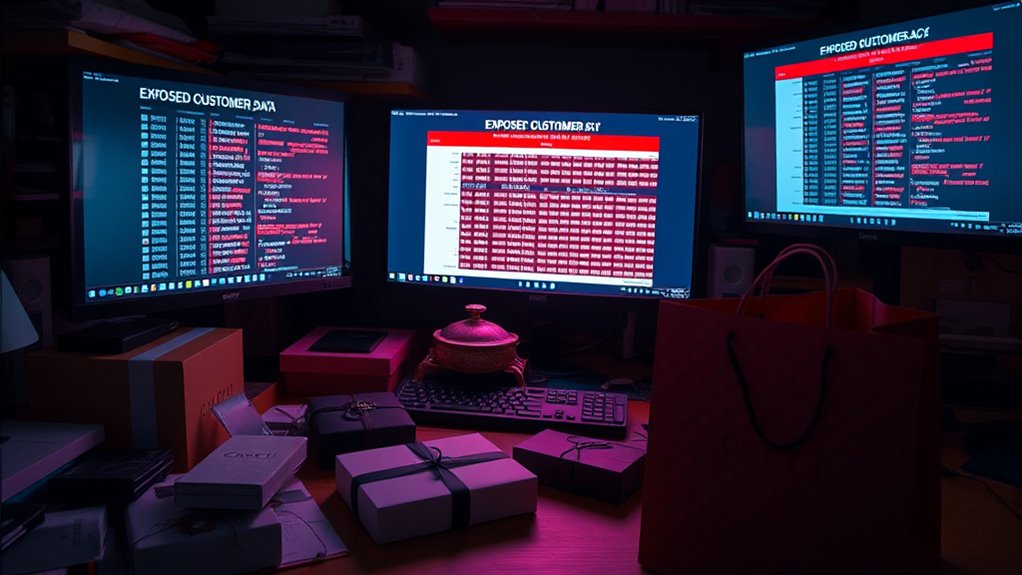A major security failure has exposed the personal details and shopping habits of millions associated with Gucci, Balenciaga, Alexander McQueen, and Brioni. Hackers exploited vulnerabilities in the brands’ Salesforce systems, leaking names, addresses, phone numbers, and email addresses. While financial data remained secure, this breach risks identity theft and scams. Law enforcement and brands are now strengthening defenses, but if you want to understand how this happened and what it means for you, keep exploring further.

A recent cyberattack has compromised the data of Gucci-Group brands, including Gucci, Balenciaga, Alexander McQueen, and Brioni, highlighting a growing threat to the luxury fashion sector. If you’re a customer or stakeholder, this breach serves as a stark reminder that even the most prestigious brands are vulnerable to sophisticated cyber threats. The attack was carried out by ShinyHunters, a notorious hacking group known for breaching high-profile targets. It was initially reported in 2024 as affecting Gucci, but by June 2025, the full scope was confirmed, revealing nearly 43 million Gucci customer records and an additional 13 million from Balenciaga, Alexander McQueen, and Brioni. These figures include personal details like names, birth dates, phone numbers, email and physical addresses, and insights into customer spending habits. While sensitive financial data such as credit card numbers or bank details remained untouched, the leaked information could still compromise your privacy and security, especially if your profile was among those exposed. The breach exploited a vulnerability in Salesforce’s CRM system, which the brands used to manage customer relationships. Once inside, the hackers gained access to a treasure trove of personal data and shopping profiles, revealing how much customers spent across these luxury brands. Although transaction specifics and financial data weren’t stolen, the leaked spending patterns could be used for targeted scams or identity theft. Some affected individuals have already been publicly identified from leaked databases, heightening the risk of further misuse. The attack underscores how cybercriminals are shifting their tactics to target industries that hold high-value personal data, with fashion retail increasingly becoming a lucrative target. The breach also exposed vulnerabilities in the brands’ cybersecurity measures, which are critical to address in order to prevent future attacks. ShinyHunters claimed responsibility for the breach and reportedly engaged in negotiations with Balenciaga over a ransom of approximately €750,000 payable in Bitcoin. In response, authorities in Paris swiftly acted, arresting individuals believed to be leaders within the hacking group and their affiliates, emphasizing law enforcement‘s focus on dismantling cybercrime networks impacting global luxury brands. In the aftermath, Kering, the parent company, promptly took steps to bolster its cybersecurity defenses. They disclosed the breach to authorities and customers, fulfilling legal requirements, though they didn’t specify which countries or brands were most affected. This incident emphasizes the rising costs and risks associated with cyberattacks in the luxury retail sector. Cybercrime-related expenses are projected to reach $10.5 trillion globally by 2025, marking a threefold increase over the past decade. Such breaches threaten customer trust, damage brand reputations, and invite regulatory penalties. For consumers, it’s a wake-up call to remain vigilant and monitor accounts closely, especially when personal and spending data might be compromised. As luxury brands continue to digitize, their security measures must evolve to prevent similar breaches, safeguarding both their reputation and their customers’ privacy.
Frequently Asked Questions
How Long Has the Data Leak Been Ongoing?
The data leak has been ongoing since at least April 2025, when the main breach at Kering was detected. Hackers initially gained access in 2024, and data extraction continued for months before Kering discovered it in June 2025. During this time, sensitive customer information was repeatedly accessed and stolen, with ongoing activity including ransom negotiations, making the breach active for over a year before authorities intervened.
Were Customer Payment Details Compromised?
Your financial data stayed locked tight, like a vault with no cracks. The hackers didn’t get their hands on your bank account numbers or credit card details. Kering confirmed that payment information remained secure, acting like a shield protecting your money from the storm. So, rest assured, your payment details were safe, and no financial information was compromised, keeping your trust intact amid the chaos.
What Steps Are Gucci-Group Brands Taking to Prevent Future Leaks?
You’re implementing advanced intrusion detection and prevention systems to monitor threats in real-time. You’re strengthening network segmentation to limit lateral movement and upgrading encryption protocols to protect stored customer data. You’re conducting thorough forensic analyses to patch vulnerabilities, increasing internal security audits, and revising cybersecurity policies. Additionally, you’re training employees, managing third-party risks, collaborating with experts, and sharing threat intelligence. These steps collectively aim to prevent future data leaks and secure customer information effectively.
How Many Customers Were Affected by the Breach?
You’re affected if you’re among the 7.4 million customers whose data was exposed in the Gucci breach. This number highlights the massive scale of the leak, impacting millions across brands like Balenciaga and Alexander McQueen worldwide. While exact figures for Gucci alone aren’t public, the breach includes detailed contact info and purchase histories, increasing your risk of targeted scams and identity theft. Stay vigilant and monitor your accounts closely.
Has Any Legal Action Been Initiated Against the Perpetrators?
No, as of now, no formal legal actions have been initiated against the perpetrators. While law enforcement has arrested members linked to ShinyHunters, the group responsible for the breach, charges haven’t been publicly filed yet. Authorities are still investigating, and legal proceedings may follow. Meanwhile, affected customers and advocacy groups are monitoring the situation, with potential claims against Kering for data protection failures still under consideration.
Conclusion
This leak serves as a stark reminder that even the most glamorous façades can hide vulnerabilities. Like a fragile silk thread suddenly snapping, your personal data can unravel when least expected. Guard your information as fiercely as a treasure guarded by dragons, for in today’s digital domain, complacency leaves you exposed. Remember, behind every polished brand lies a hidden chamber—one breach can echo like a thunderclap through your privacy. Stay vigilant, stay secure.










